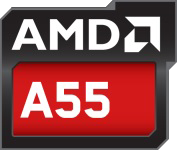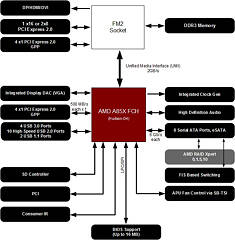 91
91
AMD Elite A-Series A10-6800K APU (Socket FM2) Review
AMD Elite A-Series APU Design »AMD FM2 Chipsets

The A55 has SATA 3 Gb/s support and supports a single VGA slot. The AMD A55 clearly targets signage boxes and, perhaps, light office clients. It is meant to be used with both A6 and A4 APU products.

The AMD A75 offers SATA 6Gb/s support (six ports in total are supported natively), adds FIS-based switching for those SATA ports, and has native USB 3.0 support. The AMD A75 is really for mainstream users, like your mom or dad who are also interested in snappy drive and external device operation, thanks to native USB 3.0 and that SATA 6 Gb/s support; it is obviously geared towards both A8 and A6 APUs.

The AMD A85X supports eight total SATA 6 Gb/s ports with FIS-based switching and adds in CrossfireX support. The new AMD A85X targets gamers and enthusiasts, and those that like to keep up with the latest and greatest in technology. AMD's intention is for you to pair this chipset up with AMD A10, AMD A8, and "K"-level, "Unlocked" APUs.
In the end, it's pretty basic. Each chipset, or Fusion Controller Hub (FCH for short), has its specific use and, thereby, a specific target market. Those that don't need as much can pick a chipset that doesn't give them as much while, at the same time, saving money through features that chipset lacks. It looks like you might get exactly what you pay for. The AMD A85X is AMD's high-end chipset. AMD sent me the above block diagram of its FCH functionality. It shows all the features and which part of the platform, whether APU or FCH, supports which features. These essentially remain the same as they were before, with the changes the new AMD Elite A-Series APUs bring forward.
Feb 21st, 2025 05:00 EST
change timezone
Latest GPU Drivers
New Forum Posts
- [PCGamer] Former Sony exec finally says the quiet part out loud: putting PlayStation games on PC is 'almost like printing money' (27)
- 3D Printer Club (424)
- Get ready to open your wallets people (44)
- Dune: Awakening benchmark - post your results (0)
- Will undervolting a 4090 keep the connector from melting? A discussion about electrical theory. (22)
- Should I make a thermal maintenance on my GPU? (67)
- Free Games Thread (4481)
- What local LLM-s you use? (56)
- Whats your favourite Linux Distro? (223)
- First ever PC build (11)
Popular Reviews
- MSI GeForce RTX 5070 Ti Ventus 3X OC Review
- Gigabyte GeForce RTX 5090 Gaming OC Review
- Galax GeForce RTX 5070 Ti 1-Click OC White Review
- ASUS GeForce RTX 5070 Ti TUF OC Review
- Ducky One X Inductive Keyboard Review
- MSI GeForce RTX 5070 Ti Vanguard SOC Review
- AMD Ryzen 7 9800X3D Review - The Best Gaming Processor
- MSI GeForce RTX 5070 Ti Gaming Trio OC+ Review
- MSI MAG Z890 Tomahawk Wi-Fi Review
- NVIDIA GeForce RTX 5080 Founders Edition Review
Controversial News Posts
- AMD Radeon 9070 XT Rumored to Outpace RTX 5070 Ti by Almost 15% (302)
- AMD Plans Aggressive Price Competition with Radeon RX 9000 Series (257)
- AMD is Taking Time with Radeon RX 9000 to Optimize Software and FSR 4 (256)
- AMD Radeon RX 9070 and 9070 XT Listed On Amazon - One Buyer Snags a Unit (242)
- Edward Snowden Lashes Out at NVIDIA Over GeForce RTX 50 Pricing And Value (241)
- AMD Denies Radeon RX 9070 XT $899 USD Starting Price Point Rumors (239)
- New Leak Reveals NVIDIA RTX 5080 Is Slower Than RTX 4090 (215)
- AMD Radeon RX 9070 XT Launch Allegedly Set for March 6 (152)
